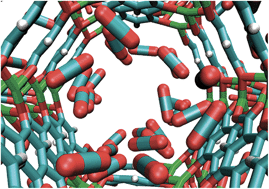Model reduction by coarse-graining the diffusion propagator in complex media
Model reduction by coarse-graining the diffusion propagator in complex media
Promotor(en): A. Ghysels /16MODEV01 / Model and software developmentDiffusion of molecules is the result of a molecule hopping over a multitude of barriers. This slow process may be modeled with molecular dynamics simulations, where Newton’s equations are integrated. The molecules will travel on average over a certain distance: at first they move in a ballistic way, but at longer time scales, the mean square distance (MSD) becomes linear with time in the diffuse regime. The problem is that it is computationally costly to simulate large systems using an all-atom description for such long times. Reducing the number of degrees of freedom in the simulation would help decrease the computational cost. Unfortunately, such a coarse-graining process will affect the dynamics of the original system, and it is in general not guaranteed that coarse-graining conserves the underlying true dynamics of the all-atom system. While the coarse-grained system allows to reach longer time scales, the simulated diffusion is no longer reliable.

FIG. 1. Diffusion of CO2 molecules in a porous ZIF framework: an inhomogeneous and anisotropic medium.
FIG. 2 Large phospholipid molecules diffuse in biological membrane: lateral diffusion, rotation, swing, flexion, transverse diffusion. Model reduction will help to reduce the computational cost for modeling these large molecules, which diffuse slowly and have a high number of degrees of freedom.Goal
In this thesis, it will be investigated how model reduction may be applied on all-atom simulations while conserving the underlying true dynamics. The first part of the thesis will be the generation of reference all-atom diffusion data. From these data, the diffusion constant should be extracted by fitting the slope of the MSD-versus-time curve. In inhomogeneous or anisotropic media, such as adsorbated diffusing in the channels of a porous crystal, inverse Monte Carlo should be used. The inverse Monte Carlo technique searches for the optimal diffusive model that may explain the observed molecular trajectories, and this model gives a theoretical propagator for the diffusion process. It is based on the discretization of the Smoluchowsky equation (Fokker-Planck equation), which a generalization of the diffusion equation to inhomogeneous media. The concept of this propagator P(r,t|r’) is similar to a Green’s function: it gives the probability of reaching a certain location r within a given lag time t, given that the particle started at some initial position r’. The reference all-atom data will serve as the benchmark for the later coarse-grained simulations.
The second part of the thesis will be the design of a coarse-graining method that best conserves the dynamics. The initial focus will be on the coarse-graining of the propagator itself. After having derived a theoretical propagator for the all-atom system, this propagator will be reduced in dimension. The inspiration for this reduction is recent work by Hummer et al., which explicitly wrote down the required conditions in the reduction, in order to conserve the dynamics. Hummer’s idea should be generalized to inhomogeneous and anisotropic media, and be validated against the reference data. The validation should include both accuracy and computational cost. Another option is to run coarse-grained dynamics simulations, where atoms are lumped together to form a set of interacting heavy beads. The trajectories of these beads should then be compared against the trajectories of the all-atom molecules. Adapting the interaction models for the heavy beads is a method to obtain the correct dynamics at the coarse-grained scale. In literature, this approach has been attempted with limited success, as it is hard to be generalized. The option of coarse-grained beads will nevertheless be tested in order to measure how it compares to coarse-graining the propagator. The extensiveness of the investigation will depend on the interest of the student.
In this thesis, the student will develop skills in statistical physics, molecular modeling, data analysis, thermodynamics, and method development. It combines theoretical derivations with practical implementations, and the thesis is most suited for a student with a strong interest in both aspects.
Mobility
This research topic will be conducted in the framework of a strong international network and if possible the student will be actively involved in work discussions with collaborative partners.Motivation Appl. Phys.
The physics aspect is the theoretical development of a reduction method that obeys statistical thermodynamics. The engineering aspect is the implementation, validation, and optimization of the reduction scheme.
- Study programmeMaster of Science in Engineering Physics [EMPHYS], Master of Science in Physics and Astronomy [CMFYST]ClustersFor Engineering Physics students, this thesis is closely related to the cluster(s) NANO, MODELING, METHOD DEVELOPMENT


